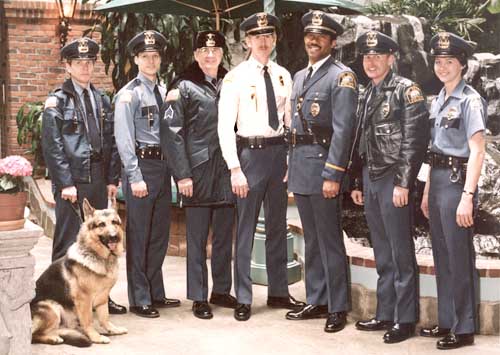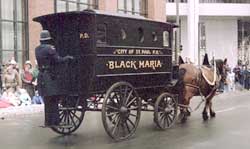In the Beginning — 11
After more than fifty years of service, the Public Safety Building, constructed in 1929, demanded major repair. The building originally housed the combined headquarters of the city’s Police, Fire, and Health Departments, although the Health Department moved to its own building in 1958. The renovation of the Public Safety Building included replacement of interior walls and many of the mechanical systems, plus installation of central air conditioning. The building was connected to the downtown district heating system and windows were replaced with decorative, energy efficient, tinted glass. The entrance was moved from the Tenth Street side to the Eleventh Street side, mandating a change of address from 101 E. Tenth Street to 100 E. Eleventh Street.
A partnership between the Saint Paul School District and the Saint Paul Police Department was established in 1985 when two police officers were assigned to Central High School. This initiated what became School Resource Officers. Today, seventeen School Resource Officers work in the schools: seven officers in the high schools, four officers in the middle schools and six officers working the D.A.R.E. program. Being cross-trained, the D.A.R.E. officers can assist with problems in the schools when not teaching.

The Saint Paul Police Department was recognized as the “Best Dressed Municipal Police Department With Over 200 Officers in the United States” by the National Association of Uniform Manufacturers in 1985.
Amidst concern for the widespread abuse of drugs and alcohol throughout our nation, the Saint Paul Police Department acknowledged the need for an employee drug testing program within the agency. Throughout 1986, Department administrators and the Police Federation negotiated a comprehensive alcohol and drug testing policy and procedure. This agreement ensured the integrity of essential services and assisted in maintaining community confidence.
 During the 1986 Winter Carnival festivities, the Saint Paul Police
Department unveiled the restored 1897 horse-drawn paddy wagon (workhouse
van), which was known during that era as the “Black Maria.”
Originally in service during the late 1890's, the wagon was discovered
in a transportation museum in Clearwater, Florida. When the museum
owner died, a private collector purchased the wagon and moved it
to Cleveland, Ohio, where it stayed until Department personnel learned
of its existence. The Black Maria was transported back to Saint Paul
in February of 1986, four days before it was to be unveiled for the
100th Saint Paul Winter Carnival parade. This piece of police history
was purchased with community donations of $10,000. The horse-drawn
wagon can be seen today “on patrol” at many parades and
functions with officers in period dress.
During the 1986 Winter Carnival festivities, the Saint Paul Police
Department unveiled the restored 1897 horse-drawn paddy wagon (workhouse
van), which was known during that era as the “Black Maria.”
Originally in service during the late 1890's, the wagon was discovered
in a transportation museum in Clearwater, Florida. When the museum
owner died, a private collector purchased the wagon and moved it
to Cleveland, Ohio, where it stayed until Department personnel learned
of its existence. The Black Maria was transported back to Saint Paul
in February of 1986, four days before it was to be unveiled for the
100th Saint Paul Winter Carnival parade. This piece of police history
was purchased with community donations of $10,000. The horse-drawn
wagon can be seen today “on patrol” at many parades and
functions with officers in period dress.
The Police Chaplain Program was again “resurrected” in 1986 with the assistance of the Saint Paul Area Council of Churches, rendering a solid partnership between the Saint Paul Police Department and the religious community. The corps of twenty-one chaplains worked with officers and underwent specialized training. Among other services, police chaplains provided counseling, crisis intervention, and visitation with victims of crime, as well as with the incarcerated. To this day the program remains strong, and the chaplains are available 24 hours a day, 365 days a year.
 1987 brought a major change with the transition from the .38 caliber
police service revolver to the newly issued Glock 9mm, semi-automatic
pistol. The Department’s range staff taught a two-day course
for all sworn officers, which included class instruction on safe
handling practices, marksmanship, defense methods, and weapon care.
These firearm principles were then reinforced with live-fire exercises
at the outdoor range. Several reasons determined the Glock’s
adoption as the Department’s new weapon-of-choice: increased
firepower, number of available rounds, interchangeable parts, easy
cleaning and maintenance, suitability to a variety of hand sizes,
and less recoil when compared to many other police service handguns.
1987 brought a major change with the transition from the .38 caliber
police service revolver to the newly issued Glock 9mm, semi-automatic
pistol. The Department’s range staff taught a two-day course
for all sworn officers, which included class instruction on safe
handling practices, marksmanship, defense methods, and weapon care.
These firearm principles were then reinforced with live-fire exercises
at the outdoor range. Several reasons determined the Glock’s
adoption as the Department’s new weapon-of-choice: increased
firepower, number of available rounds, interchangeable parts, easy
cleaning and maintenance, suitability to a variety of hand sizes,
and less recoil when compared to many other police service handguns.
Habitual offenders committing crimes in Saint Paul encountered an unprecedented program in 1988. These career criminals were identified as persons with five or more felony arrests in a two-year period. They would become recipients of enhanced investigation aimed at building a solid legal case, resulting in substantial time behind bars.
The use of ballistic vests have proven to be a valid safety precaution, and they became mandatory for all Patrol Division personnel in 1988. Officers paid for one-third of the vest cost from their Department clothing allowance, while the other two-thirds came from the Police Federation and the State of Minnesota. Annually, these ballistic vests have been credited with saving many officers’ lives nation-wide.
 Saint Paul’s Ordnance Disposal Unit (O.D.U.) was the recipient
of one of the finest explosive demolition, storage and training ranges
in the United States through a long-term lease with the University
of Minnesota. In partnership with the Minneapolis Bomb Squad, Saint
Paul’s unit upgraded a thirty-two acre site in Dakota County
to a state-of-the-art facility surrounded by an eight-foot fence
capped with barbed wire. Improvements included creation of large
earth berms, concrete bunkers and underground wiring for disposal
of the explosive or dangerous materials collected by the O.D.U. Most
other Bomb Squads around the country found a local gravel pit or
open space away from metropolitan areas to detonate or render safe
explosives, but Saint Paul could now bring bombs, fireworks and explosive
chemicals to this new facility and safely store or detonate them.
This was quite an improvement over the Pig’s Eye dump!
Saint Paul’s Ordnance Disposal Unit (O.D.U.) was the recipient
of one of the finest explosive demolition, storage and training ranges
in the United States through a long-term lease with the University
of Minnesota. In partnership with the Minneapolis Bomb Squad, Saint
Paul’s unit upgraded a thirty-two acre site in Dakota County
to a state-of-the-art facility surrounded by an eight-foot fence
capped with barbed wire. Improvements included creation of large
earth berms, concrete bunkers and underground wiring for disposal
of the explosive or dangerous materials collected by the O.D.U. Most
other Bomb Squads around the country found a local gravel pit or
open space away from metropolitan areas to detonate or render safe
explosives, but Saint Paul could now bring bombs, fireworks and explosive
chemicals to this new facility and safely store or detonate them.
This was quite an improvement over the Pig’s Eye dump!
Around 1900, the introduction of fingerprint analysis revolutionized the identification of criminals. The Saint Paul Police Department led the way in fingerprint technology in 1988. The Department received a novel “inkless” fingerprint system which used sophisticated cameras to capture the prints’ image. A printer then created a hard copy of the fingerprint. Only one other metropolitan agency had this technology at the time.
The nature of law enforcement can, at times, put police officers in conflict with news reporters. In 1988, Saint Paul joined a growing list of law enforcement agencies, who had taken a step toward improving police-media relations by adding a media expert. Paul Adelmann, an award-winning television news producer with sixteen years experience, was hired as the Public Information Coordinator (P.I.C.) for the Department. The P.I.C. took charge of all Departmental news releases and coordinated news conferences, both at headquarters and at the scene of major events.

